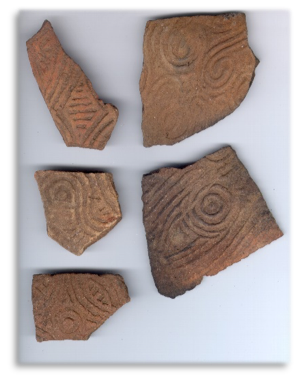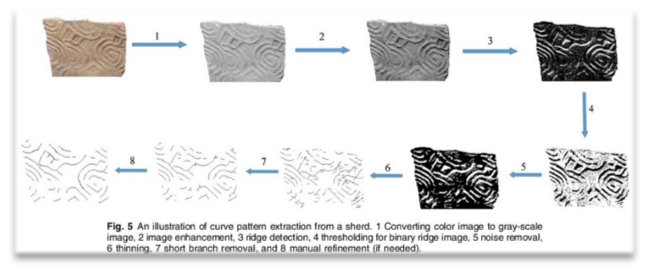Modern Heritage Foundation
Leake Site
Leake Site Swift Creek Complicated Stamped Design Study
 The diverse designs stamped into the exterior of pottery vessels
made by American Indians in the area of the southeastern United States
provide an almost unprecedented opportunity to track human interaction
through the study of inter-site patterning among unique paddle designs.
This paddle stamped pottery made circa 100 – 800 A.D., is known as Swift
Creek Complicated Stamped pottery. As early as the 1940s, archaeologists
increasingly realized that 1) complete paddle designs could be reconstructed
from fragmentary impressions on sherds, and 2) certain paddle designs were
widely distributed across the region, sometimes found hundreds of kilometers
apart. These ideas led archaeologist Bettye Broyles and naturalist and amateur
archaeologist Frankie Snow to devote a significant amount of time to the study
of individual pottery sherds for information on paddle designs. Thanks to their
efforts, we now have a comparative collection of over 525 reconstructed Swift
Creek paddle designs from dozens of archaeological sites, and ongoing work by
numerous researchers are expanding the body of known designs several fold. Despite
these advances, we lack efficient methods for combing through the volumes of
material from Swift Creek sites that reside in curation facilities across the
Southeast. Finding sherds that match a particular known design is akin to finding
the proverbial needle in a haystack.
The diverse designs stamped into the exterior of pottery vessels
made by American Indians in the area of the southeastern United States
provide an almost unprecedented opportunity to track human interaction
through the study of inter-site patterning among unique paddle designs.
This paddle stamped pottery made circa 100 – 800 A.D., is known as Swift
Creek Complicated Stamped pottery. As early as the 1940s, archaeologists
increasingly realized that 1) complete paddle designs could be reconstructed
from fragmentary impressions on sherds, and 2) certain paddle designs were
widely distributed across the region, sometimes found hundreds of kilometers
apart. These ideas led archaeologist Bettye Broyles and naturalist and amateur
archaeologist Frankie Snow to devote a significant amount of time to the study
of individual pottery sherds for information on paddle designs. Thanks to their
efforts, we now have a comparative collection of over 525 reconstructed Swift
Creek paddle designs from dozens of archaeological sites, and ongoing work by
numerous researchers are expanding the body of known designs several fold. Despite
these advances, we lack efficient methods for combing through the volumes of
material from Swift Creek sites that reside in curation facilities across the
Southeast. Finding sherds that match a particular known design is akin to finding
the proverbial needle in a haystack.
 In order to increase the efficiency of such efforts, Dr. Karen Smith of the
South Carolina Institute for Anthropology and Archaeology (SCIAA) is leading an
effort to develop a computer application designed to identify identical complicated
stamped pottery designs. Named SnowVision after Frankie Snow, this automated analysis
and matching application for complicated stamped designs has enormous potential to yield
significant insight into the nature of Woodland and Mississippian period American Indian
interaction, cultural identity, religion, art, and settlement. A computer application
that can both reliably and quickly match pottery designs will be a major technological and
analytical advancement that will facilitate and advance archaeological research of the
late precontact time frame in southeastern North America. Also, not only will this tool
be useful for matching Swift Creek pottery designs of the Middle to Late Woodland era, but
it could be used for the complicated stamped pottery designs produced in the succeeding
Mississippian period. Even further, the application may eventually be amenable for development
to accept other types of designs found on other artifacts, such as embossing for a trademark
on a historic period artifact.
In order to increase the efficiency of such efforts, Dr. Karen Smith of the
South Carolina Institute for Anthropology and Archaeology (SCIAA) is leading an
effort to develop a computer application designed to identify identical complicated
stamped pottery designs. Named SnowVision after Frankie Snow, this automated analysis
and matching application for complicated stamped designs has enormous potential to yield
significant insight into the nature of Woodland and Mississippian period American Indian
interaction, cultural identity, religion, art, and settlement. A computer application
that can both reliably and quickly match pottery designs will be a major technological and
analytical advancement that will facilitate and advance archaeological research of the
late precontact time frame in southeastern North America. Also, not only will this tool
be useful for matching Swift Creek pottery designs of the Middle to Late Woodland era, but
it could be used for the complicated stamped pottery designs produced in the succeeding
Mississippian period. Even further, the application may eventually be amenable for development
to accept other types of designs found on other artifacts, such as embossing for a trademark
on a historic period artifact.
 This project involves the 3D data collection of the designs stamped into the exterior of
Swift Creek vessels recovered from the Leake Site. Located in northwest Georgia, Leake was a
large multi-mound ceremonial center at which people from throughout the Southeast and the Midwest
came together. Several thousand complicated stamped sherds have been recovered from the site,
including one that was shown through ceramic petrography to have been made at the Mann Site, a
Hopewellian ceremonial center in southwestern Indiana. A visual effort to match designs found
at Leake with those from other sites resulted in 13 matches to other sites in Georgia and Florida.
It is expected that this design collection and analysis effort will identify many more matches of
Leake pottery with that from other Swift Creek sites throughout the Southeast, and possibly with
the few sites in the Midsouth and the Midwest that contain Swift Creek pottery. In addition to
identifying design matches and greatly increasing the design database of SnowVision, this project
will also introduce students to archaeological research, train students in the use of innovative
and advanced technological tools in modern archaeological analyses, and will also expose them to
the significant American Indian ceramic design style and stamping tradition that lasted over 1,000
years in the Southeast.
This project involves the 3D data collection of the designs stamped into the exterior of
Swift Creek vessels recovered from the Leake Site. Located in northwest Georgia, Leake was a
large multi-mound ceremonial center at which people from throughout the Southeast and the Midwest
came together. Several thousand complicated stamped sherds have been recovered from the site,
including one that was shown through ceramic petrography to have been made at the Mann Site, a
Hopewellian ceremonial center in southwestern Indiana. A visual effort to match designs found
at Leake with those from other sites resulted in 13 matches to other sites in Georgia and Florida.
It is expected that this design collection and analysis effort will identify many more matches of
Leake pottery with that from other Swift Creek sites throughout the Southeast, and possibly with
the few sites in the Midsouth and the Midwest that contain Swift Creek pottery. In addition to
identifying design matches and greatly increasing the design database of SnowVision, this project
will also introduce students to archaeological research, train students in the use of innovative
and advanced technological tools in modern archaeological analyses, and will also expose them to
the significant American Indian ceramic design style and stamping tradition that lasted over 1,000
years in the Southeast.